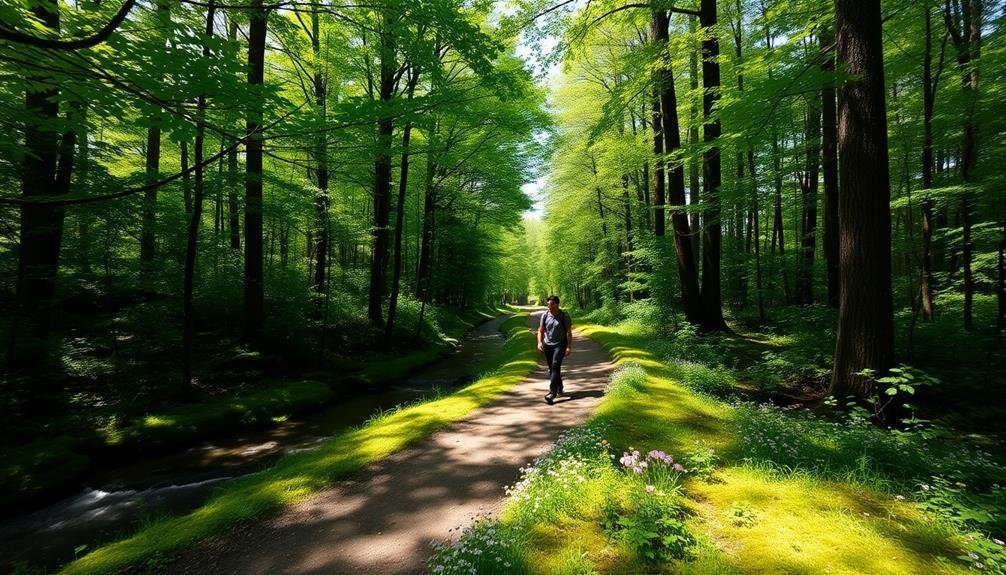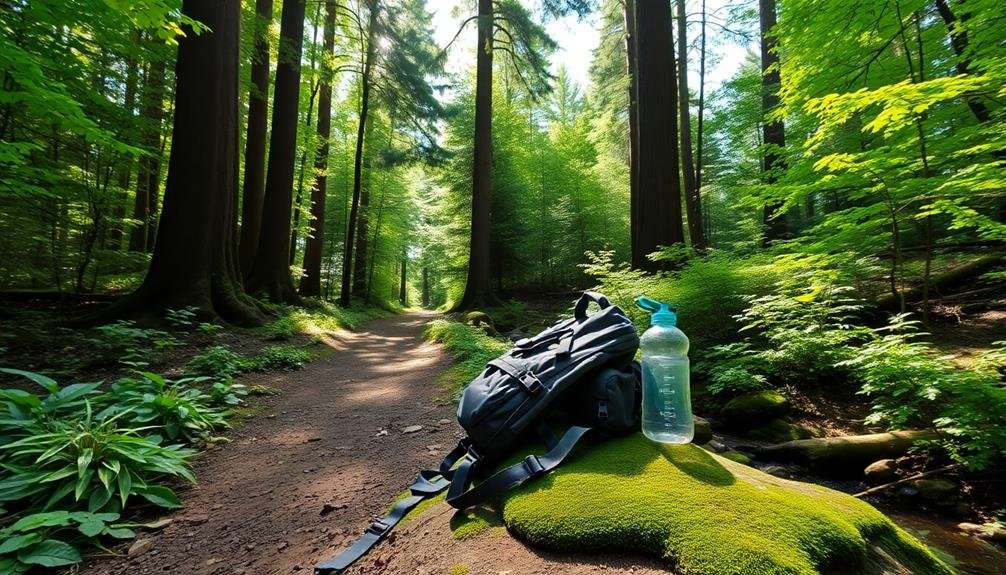Nature walks can greatly ease anxiety while hiking by connecting you with the calming effects of the outdoors. Joining guided walks enriches your experience with expert insights and offers community support. Whether you choose group or solo hikes, both provide unique advantages. Select trails that match your skill level and preferences, ensuring you'll feel comfortable and relaxed. Incorporate mindfulness techniques like deep breathing to center your thoughts and enhance the experience. Engaging with nature's beauty helps quiet the mind and reduce stress. There's so much more to explore when it comes to maximizing these benefits.
Understanding Anxiety and Nature

Anxiety often feels like a heavy weight pressing down on you, making it hard to breathe. It can manifest in various forms—racing thoughts, a racing heart, or even physical tension throughout your body. You might find yourself caught in a cycle of worry, feeling overwhelmed by daily stressors. This constant state of unease can make it difficult to focus, leading to a sense of disconnection from your surroundings.
Nature, on the other hand, offers a contrasting experience. When you step outside and immerse yourself in a natural environment, you can feel the tension easing. The sights, sounds, and smells of nature provide a sensory distraction, allowing your mind to shift focus away from anxious thoughts. You might notice the rustling leaves or the chirping of birds, grounding you in the moment.
Being in nature doesn't just serve as a temporary escape; it can also promote mental clarity and emotional balance. By understanding how anxiety affects you and recognizing the calming impact of nature, you can take proactive steps to integrate time outdoors into your routine, helping to alleviate that heavy weight over time.
Benefits of Guided Nature Walks
Guided nature walks offer a structured way to experience the calming effects of the outdoors while benefiting from expert insights. When you join a guided walk, you gain access to knowledgeable leaders who can share fascinating information about local flora, fauna, and ecosystems. This knowledge enriches your experience, making each step feel more meaningful.
You'll also find that guided walks often encourage a sense of community. Sharing the experience with others can help alleviate anxiety, as you connect with like-minded individuals who appreciate nature's beauty. This camaraderie creates a support system that makes the walk even more enjoyable.
Additionally, guided walks can cater to various skill levels, ensuring you're comfortable and confident throughout the journey. You won't need to worry about finding your way on the trail or getting lost; your guide will handle all the logistics, allowing you to focus on soaking in the serene surroundings.
Lastly, the structured nature of these walks can help reduce decision fatigue, making it easier for you to unwind. With all these benefits, guided nature walks can be a powerful tool in managing anxiety while reconnecting with nature.
Choosing the Right Trail

When choosing a trail, consider the difficulty level that matches your fitness and comfort.
Scenic views can enhance your experience, so look for paths that offer beautiful landscapes along the way.
Don't forget to think about the trail length—too short might leave you wanting more, while too long could add unnecessary stress.
Trail Difficulty Levels
Choosing the right trail can make all the difference in your nature walk experience. It's crucial to reflect on trail difficulty levels when planning your hike. Trails are typically categorized as easy, moderate, or difficult. Understanding these classifications helps you select a trail that matches your fitness level and comfort.
If you're new to hiking or looking for a relaxed experience, opt for an easy trail. These paths usually have minimal elevation changes and well-maintained surfaces, making them perfect for beginners or those seeking a leisurely outing.
Moderate trails may include some elevation gain and uneven terrain, so they're great for individuals with a bit more hiking experience.
Difficult trails, on the other hand, often involve steep climbs, rocky paths, or longer distances. If you're confident in your physical abilities and enjoy a challenge, these trails can provide a rewarding experience. However, they can also lead to frustration or injury if you're not adequately prepared.
Always check the trail descriptions, and don't hesitate to seek advice from local park rangers or fellow hikers. By choosing the right trail, you set the stage for a fulfilling and anxiety-easing nature walk.
Scenic Views Importance
Selecting a trail with stunning scenic views can greatly enhance your nature walk experience. When you're surrounded by breathtaking landscapes, it can uplift your mood and reduce anxiety.
The beauty of nature has a calming effect, allowing you to escape the hustle and bustle of everyday life. Choosing the right trail is essential for maximizing these benefits. Here are some factors to take into account:
- Diversity of Scenery: Look for trails that offer a mix of mountains, forests, and water bodies. This variety can keep your mind engaged and promote relaxation.
- Vantage Points: Trails that feature lookout points or elevated areas provide opportunities to take in expansive views, which can be invigorating and revitalizing.
- Seasonal Changes: Different times of the year offer unique scenic experiences. Autumn foliage or spring blossoms can transform a familiar trail into a new adventure.
- Wildlife Sightings: Trails that pass through natural habitats increase your chances of encountering wildlife, adding excitement and wonder to your walk.
Trail Length Considerations
Finding the right balance in trail length is essential for a fulfilling nature walk. You want to choose a trail that matches your fitness level and available time.
If you're new to hiking or feeling anxious, starting with shorter trails can offer a less intimidating experience. A 1 to 3-mile loop can provide the satisfaction of completing a hike without overwhelming you.
On the other hand, if you're feeling more adventurous and have built up some stamina, consider longer trails that challenge you physically and mentally.
Trails between 5 to 10 miles can provide a sense of accomplishment and allow you to immerse yourself in nature more deeply.
Mindfulness Techniques While Hiking
When you hit the trail, take a moment to focus on your breathing; this simple act can ground you in the present.
As you walk, pause to observe the beauty of the surrounding nature, letting the sights and sounds wash over you.
These mindfulness techniques not only enhance your hike but also help ease anxiety.
Focus on Breathing
Breathing deeply can transform your hiking experience, grounding you in the present moment. As you step into nature, focus on your breath to calm your mind and connect with your surroundings.
This mindfulness technique helps you let go of distractions and worries, allowing you to fully immerse yourself in the beauty of the trail.
To enhance your breathing practice while hiking, consider these tips:
- Inhale through your nose: This warms and filters the air, making it easier on your lungs.
- Exhale slowly through your mouth: Letting your breath out gradually can help release tension and anxiety.
- Count your breaths: Try a pattern, like inhaling for four counts and exhaling for six. This rhythm can promote relaxation.
- Sync your breath with your steps: Inhale for a few steps and exhale for a few steps, creating a natural flow that keeps you focused.
Observe Surrounding Nature
Nature offers a vibrant tapestry of sights and sounds that can draw you into a state of mindfulness while hiking. When you immerse yourself in the natural world, you'll notice how it encourages a deep connection with your surroundings. Paying attention to the details around you can help quiet your mind and reduce anxiety.
Here's a simple guide to enhance your observation skills:
| What to Observe | Mindfulness Benefit |
|---|---|
| Colors of the leaves | Boosts mood and enhances focus |
| Sounds of the birds | Calms the mind and reduces stress |
| Texture of the bark | Increases awareness and grounding |
| Movement of the water | Encourages letting go of worries |
| Shapes of clouds | Inspires creativity and relaxation |
As you hike, take a moment to pause and engage with these elements. Notice how the colors shift, how the sounds blend, and how everything around you contributes to the experience. This practice helps anchor you in the present moment, allowing nature to soothe your anxiety and elevate your sense of well-being.
Connecting With Nature

Many people find solace in their surroundings, especially when they step outside and immerse themselves in the great outdoors. Connecting with nature isn't just about the sights you see; it's about engaging your senses and allowing the environment to ground you.
As you walk, take a moment to breathe in the fresh air and feel the textures around you. This connection can greatly reduce anxiety and enhance your overall well-being.
Here are some ways to deepen your connection with nature during your walks:
- Listen to the sounds: Pay attention to rustling leaves, chirping birds, or the gentle flow of water. These natural sounds can create a calming atmosphere.
- Touch the earth: Feel the ground beneath your feet, or run your fingers over tree bark. This tactile experience can anchor you in the moment.
- Observe wildlife: Spotting animals in their natural habitat can remind you of the beauty and complexity of life.
- Mindful breathing: Synchronize your breath with the rhythm of nature. Inhale the scents of flowers or pine, and exhale your worries.
Embrace these moments, and let nature work its magic on your mind.
Group vs. Solo Walks
Walking with others or venturing out on your own can both offer unique benefits for easing anxiety. When you join a group, you create a sense of camaraderie. Sharing the experience with friends or fellow hikers can foster a supportive atmosphere, helping you feel less isolated. The conversations and laughter can distract your mind from worries, allowing you to immerse yourself in the beauty of nature.
Plus, there's something comforting about being surrounded by others who share your passion for the outdoors.
On the other hand, solo walks provide a different type of relief. Being alone in nature allows you to connect deeply with your surroundings and reflect on your thoughts without distractions. You can set your own pace, choose your own path, and immerse yourself fully in the moment.
This solitude can be incredibly liberating, giving you the space to breathe and recharge.
Ultimately, whether you choose to walk with a group or go solo, both options can help ease anxiety. It's about finding the right balance and what feels best for you.
Experiment with both to discover what brings you the most peace and joy in your nature walks.
Preparing for Your Nature Walk

Before heading out on your nature walk, it's important to prepare properly to guarantee a fulfilling experience.
Taking a few moments to gather your essentials can make a big difference in how much you enjoy the outdoors. Here are some key items to take into account packing:
- Comfortable Footwear: Choose shoes that provide good support and grip, tailored for the terrain you'll encounter.
- Weather-Appropriate Clothing: Dress in layers to regulate your body temperature, and don't forget a hat or sunglasses for sun protection.
- Hydration and Snacks: Bring enough water to stay hydrated and pack light, nutritious snacks for energy along the way.
- Navigation Tools: Whether it's a map, GPS, or a mobile app, make sure you have a reliable way to find your way.
Incorporating Breathing Exercises
As you immerse yourself in nature, incorporating breathing exercises can greatly enhance your experience and help ease anxiety.
Start by finding a quiet spot along your hike, where you can pause and connect with your surroundings. Take a deep breath in through your nose, allowing your abdomen to expand fully. Hold that breath for a moment, then exhale slowly through your mouth, letting go of any tension.
Repeat this process several times. You might also try the 4-7-8 technique: inhale for four seconds, hold for seven, and exhale for eight. This rhythmic pattern not only calms your mind but also helps reset your body's stress response.
As you walk, maintain a steady rhythm with your breath. Breathe in for a count of four steps and out for a count of four steps. This practice keeps you grounded in the moment and connects your physical movement with your breath.
When you feel anxiety creeping in, return to these exercises. They'll help center you, bringing your focus back to the beauty of nature around you and allowing you to enjoy your hike more fully.
Long-term Benefits of Hiking

Regular hiking not only provides immediate relief from anxiety but also offers long-term benefits that can greatly enhance your overall well-being.
When you make hiking a regular part of your routine, you're investing in both your mental and physical health. The fresh air and natural surroundings help to refresh your mind, while the physical activity boosts your body's resilience.
Here are some key long-term benefits you can expect from regular hiking:
- Improved cardiovascular health: Consistent hiking strengthens your heart, lowers blood pressure, and enhances circulation.
- Enhanced mood stability: Regular exposure to nature and physical activity increases serotonin levels, helping to combat mood swings and depressive feelings.
- Stronger muscles and bones: Hiking engages multiple muscle groups, improving strength and bone density over time.
- Better stress management: The combination of exercise and nature exposure equips you with tools to handle stress more effectively in your daily life.
Frequently Asked Questions
Can Children Participate in Nature Walks for Anxiety Relief?
Absolutely, kids can join nature walks for anxiety relief! These experiences let them explore, connect with nature, and find calm. Walking among trees and listening to nature's sounds helps them feel grounded and relaxed.
What Should I Wear for a Comfortable Hiking Experience?
For a comfortable hiking experience, wear moisture-wicking clothing, sturdy hiking shoes, and a breathable hat. Layer your clothes to adjust to changing temperatures, and don't forget sunscreen and insect repellent for added protection.
How Do I Find Local Nature Trails?
To find local nature trails, check online maps or hiking apps. Ask friends for recommendations, visit local parks, or join community groups. You'll discover beautiful spots to explore and enjoy nature's tranquility.
Are There Specific Trails Recommended for Beginners?
You should look for easy, well-marked trails with gentle inclines and scenic views. Local parks often have beginner-friendly paths. Check out community websites or apps for user reviews and trail ratings to help you choose.
Can Pets Join Me on Nature Walks?
Taking your pet on nature walks can enhance the experience for both of you. Just make sure they're leashed, bring water, and check trail regulations. Enjoy the fresh air and bond with your furry friend!
In Summary
Incorporating nature walks into your routine can greatly ease anxiety and promote mental well-being. By choosing the right trail, practicing mindfulness, and connecting with nature, you'll create a calming experience. Whether you opt for group walks or solo adventures, the key is to prepare and engage fully. Remember to incorporate breathing exercises to enhance relaxation. Embracing these practices not only benefits your mental health in the moment but also supports long-term wellness. So, get out there and enjoy the peace of nature!





Leave a Reply